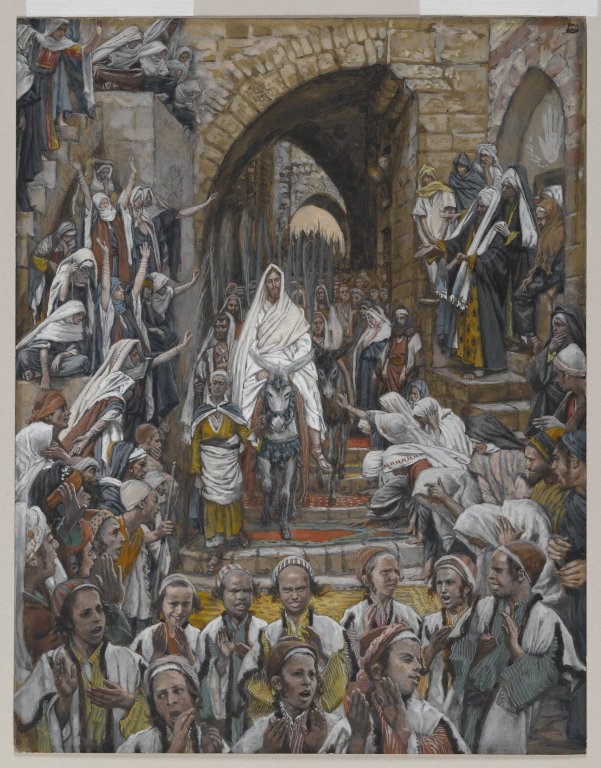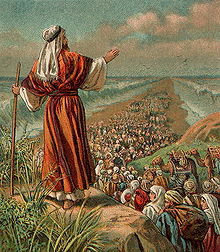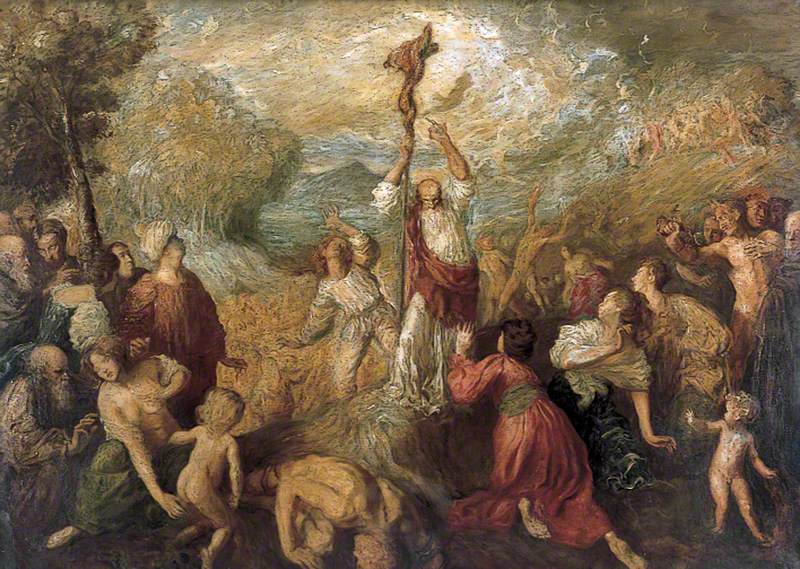
“Jesus riding on a donkey in his triumphal entry into Jerusalem …”
Holy Week is upon us. It’s the last week of Lent and the week just before Easter Sunday. (This year, April 4.) It begins with Palm Sunday and includes “Holy Wednesday (Spy Wednesday), Maundy Thursday (Holy Thursday), Good Friday (Holy Friday), and Holy Saturday.”
Notice that Holy Week doesn’t “end” with Easter Sunday. By definition, Easter Sunday “is the beginning of another liturgical week.” (Wikipedia, emphasis added.) That in turn could be a metaphor or object lesson for a whole new beginning, as in a “whole new way of life.”
Which is another way of saying Easter Sunday is the defining moment of the liturgical year…
So Holy Week begins with Palm Sunday, which commemorates “Jesus’ triumphal entry into Jerusalem, an event mentioned in each of the four canonical Gospels.” The symbolism of Jesus riding into Jerusalem on a donkey comes from Zechariah 9:9. In turn, the welcoming crowds chanted from Psalm 118:26, “Blessed is he who comes in the name of the LORD.” Further:
The symbolism of the donkey may refer to the Eastern tradition that it is an animal of peace, versus the horse, which is the animal of war. A king would have come riding upon a horse when he was bent on war and riding upon a donkey when he wanted to point out he was coming in peace. Jesus’ entry to Jerusalem would have thus symbolized his entry as the Prince of Peace, not as a war-waging king. (E.A.)
By the 16th and 17th centuries A.D., Palm Sunday got celebrated by burning a Jack-‘o’-Lent figure. “This was a straw effigy which would be stoned and abused,” designed to be a “kind of revenge on Judas Iscariot,” who had betrayed Jesus. “It could also have represented the hated figure of Winter whose destruction prepares the way for Spring.”
Holy Wednesday is also called Crooked Wednesday, Black Wednesday, or “Spy Wednesday:”
The name comes from the Bible passage read in church on that day, which explains the role that Judas Iscariot played in bringing about Jesus’ death… Although Judas was not a spy in the sense in which we use the word today, spies do perform the same kinds of treacherous acts that Judas did. In exchange for a sum of money Judas betrayed Jesus’ whereabouts to the religious authorities who sought his death.
See Spy Wednesday – Encyclopedia – The Free Dictionary.
That’s followed by Maundy Thursday, which commemorates the “Last Supper of Jesus Christ with the Apostles.” The word “Maundy” comes from the Latin mandatum or mendicare, and refers to the washing of feet that Jesus did for His disciples. (An action consistent with the “hospitality customs of ancient civilizations, especially where sandals were the chief footwear. A host would provide water for guests to wash their feet, provide a servant to wash the feet of the guests or even serve the guests by washing their feet.”)
 In John 13 (verses 1-17), the Last Supper (seen at left) was preceded by Jesus washing “His Followers’ Feet.” That act by Jesus “served the dual purpose of venerating Passover, the escape of the Jews from slavery in Egypt, and the establishment of a new tradition, Christianity.”
In John 13 (verses 1-17), the Last Supper (seen at left) was preceded by Jesus washing “His Followers’ Feet.” That act by Jesus “served the dual purpose of venerating Passover, the escape of the Jews from slavery in Egypt, and the establishment of a new tradition, Christianity.”
Another note: In John’s Gospel, the Last Supper and Crucifixion were not on “Nisan 15 (the first night of Passover),” as in the other Gospels. John had the events happening on “Nisan 14, when the Passover lambs were slaughtered. Presumably the author [John] preferred this date because it associated Jesus as the Lamb of God with the sacrificial lambs of Passover.” (Asimov)
Good Friday commemorates the trial of Jesus before Pontius Pilate, and also His conviction, Crucifixion and death at Calvary. And just as another aside, Good Friday (in a sense) marks the technical end of Lent. That is, “Hot cross buns are traditionally toasted and eaten on Good Friday,” in the Anglican countries of the British Commonwealth.
A hot cross bun is a “spiced sweet bun made with currants or raisins and marked with a cross on the top.” The eating of this hot cross bun was designed to mark the end of Lent, with all its disciplines and “giving ups.” I.e., during Lent, only “plain buns made without dairy products” could be eaten. That prohibition ended at noon on Good Friday. Also:
English folklore includes many superstitions surrounding hot cross buns. One of them says that buns baked and served on Good Friday will not spoil or grow moldy during the subsequent year… Sharing a hot cross bun with another is supposed to ensure friendship throughout the coming year… If taken on a sea voyage, hot cross buns are said to protect against shipwreck. If hung in the kitchen, they are said to protect against fires and ensure that all breads turn out perfectly.
 See Hot cross bun – Wikipedia, which includes the image at right. And as yet another aside, “On Good Friday April 14, 1865, American President Abraham Lincoln was fatally shot by actor John Wilkes Booth.”
See Hot cross bun – Wikipedia, which includes the image at right. And as yet another aside, “On Good Friday April 14, 1865, American President Abraham Lincoln was fatally shot by actor John Wilkes Booth.”
Turning to the Crucifixion itself, Asimov said John’s Gospel made a key theological point, that the Crucifixion of Jesus “on the eve of Passover is a new and greater sacrifice.” (He noted especially John 19:33 and John 19:34.)
That in turn led to the fulfilling of several prophecies about the Messiah in the Old Testament. For one thing, since Jesus was crucified on Passover, the powers that be didn’t want His body hanging on the cross into and over the Sabbath Day. That would have been ritually impure:
The next day was a special Sabbath day. The Jewish leaders did not want the bodies to stay on the cross on the Sabbath day. So they asked Pilate to order that the legs of the men be broken. And they asked that the bodies be taken down from the crosses. So the soldiers came and broke the legs of the two men on the crosses beside Jesus. But when the soldiers came close to Jesus, they saw that he was already dead. So they did not break his legs. But one of the soldiers stuck his spear into Jesus’ side. Immediately blood and water came out.
See John 19:31-34. Asimov continued that in accordance with Old Testament prophecies about the Messiah, “Not a bone of Jesus was broken but the blood of Jesus had to be seen in accordance with Exodus 12:13 and Exodus 12:46, respectively. Hence the soldiers did not break Jesus’ legs and did draw blood with the spear.” (Asimov,992-93)
To explain further, John 19:36 said, “These things happened so that the scripture would be fulfilled: ‘Not one of his bones will be broken.'” The scripture being fulfilled was Psalm 34:20 (with a “lead-in” from verse 19), “Many are the afflictions of the righteous, But the LORD delivers him out of them all. He keeps all his bones, Not one of them is broken.” (E.A.)
John 19:37 said (in the ISV), “In addition, another passage of Scripture says, ‘They will look on the one whom they pierced.'” The scripture being fulfilled there was Zechariah 12:10:
And I will pour out on the house of David and the inhabitants of Jerusalem a spirit of grace and supplication. They will look on me, the one they have pierced, and they will mourn for him as one mourns for an only child, and grieve bitterly for him as one grieves for a firstborn son. (E.A.)
 All of which referred back to the First Passover, as told in Exodus, Chapter 12, and especially in Exodus 12:3. That was when Moses – with considerable help from God – was about to deliver the original Children of Israel from their literal bondage as slaves, in the service of the Egyptian Pharoah. (As illustrated at left.) All of which could in turn serve as a possible metaphor for our being freed from spiritual bondage today:
All of which referred back to the First Passover, as told in Exodus, Chapter 12, and especially in Exodus 12:3. That was when Moses – with considerable help from God – was about to deliver the original Children of Israel from their literal bondage as slaves, in the service of the Egyptian Pharoah. (As illustrated at left.) All of which could in turn serve as a possible metaphor for our being freed from spiritual bondage today:
This month shall be the beginning of months for you; it is to be the first month of the year to you. Speak to all the congregation of Israel, saying, ‘On the tenth of this month they are each one to take a lamb for themselves, according to their fathers’ households, a lamb for each household… This is a day to remember. Each year, from generation to generation, you must celebrate it as a special festival to the Lord.
See Exodus 12: 1-3, and 14. Thus the Son of God – Jesus – was offering Himself as a “new and greater sacrifice,” as Isaac Asimov noted. In this He was doing much the same thing that Moses did when he offered up the Bronze Serpent in Numbers 21 (verses 4-9). See also Nehushtan – Wikipedia, the free encyclopedia.
I’ll be writing more next week about the Nehushtan and it’s metaphorical implications. (The key point is that “those who look to Christ are healed,” much as the ancient Hebrews – suffering from a plague of snakes – were also healed when they looked at the bronze serpent that Moses held up. See also Caduceus as a symbol of medicine – Wikipedia.)
And finally, there comes Holy Saturday, “the day before Easter and the last day of Holy Week… It commemorates the day that Jesus Christ‘s body lay in the tomb.” ‘Nuff said.
So as noted above, Holy Week ends with Saturday, and Easter Sunday “is the beginning of another liturgical week.” I’ll take up the subject of Easter next week.
And by the way, Easter is a Season, not just one day…

Moses foreshadowing the sacrifice of Jesus with his “bronze serpent…”
The upper image is courtesy of with Palm Sunday (Wikipedia). The full caption: “Jesus riding on a donkey in his triumphal entry into Jerusalem depicted by James Tissot.”
The middle image is courtesy of Last Supper – Wikipedia. The full caption: “Last Supper, Carl Bloch. In some depictions John the Apostle is placed on the right side of Jesus, some to the left.” (Judas Iscariot is seen sneaking off at the lower right.)
The “First Passover” image is courtesy of Wikipedia, the free encyclopedia. The caption reads: “Illustration of The Exodus from Egypt, 1907.”
 The lower image is courtesy of www.wikiart.org/en/augustus-john/moses-and-the-brazen-[or bronze]-serpent. Augustus John (1878-1961) was a Welsh painter, draughtsman, and etcher… His work was favourably compared in London with that of Gauguin and Matisse. He then developed a style of portraiture that was imaginative and often extravagant, catching an instantaneous attitude in his subjects.” He is shown at left on the cover of Time magazine: “‘Artist John,’ on a 1928 Time magazine cover.”
The lower image is courtesy of www.wikiart.org/en/augustus-john/moses-and-the-brazen-[or bronze]-serpent. Augustus John (1878-1961) was a Welsh painter, draughtsman, and etcher… His work was favourably compared in London with that of Gauguin and Matisse. He then developed a style of portraiture that was imaginative and often extravagant, catching an instantaneous attitude in his subjects.” He is shown at left on the cover of Time magazine: “‘Artist John,’ on a 1928 Time magazine cover.”
See also Old Testament – How does the Snake in the Desert foreshadow the coming of Jesus, Caduceus – Wikipedia, the free encyclopedia, and/or Nehushtan – Wikipedia, the free encyclopedia.
Re: Foot washing in the Old Testament. See Genesis 18:4; 19:2; 24:32; 43:24; and Ist Samuel 25:41.
Re: the length of time it took to die from crucifixion. See Crucifixion – Wikipedia. On that note, Crucifixion was intended to provide an especially slow, painful death, and gave rise to the term excruciating, literally “out of crucifying.” Frequently, “the legs of the person executed were broken or shattered with an iron club,” which act “hastened the death of the person but was also meant to deter those who observed the crucifixion from committing offenses.”
Death from crucifixion could be caused by: “cardiac rupture, heart failure, hypovolemic shock, acidosis, asphyxia, arrhythmia, and pulmonary embolism,” or a combination thereof. It could also result from other causes, “including sepsis following infection due to the wounds caused by the nails or by the scourging that often preceded crucifixion, eventual dehydration, or animal predation.”
A theory attributed to Pierre Barbet holds that, when the whole body weight was supported by the stretched arms, the typical cause of death was asphyxiation. He wrote that the condemned would have severe difficulty inhaling, due to hyper-expansion of the chest muscles and lungs. The condemned would therefore have to draw himself up by his arms, leading to exhaustion, or have his feet supported by tying or by a wood block. When no longer able to lift himself, the condemned would die within a few minutes.
Needless to say, if the condemned person’s legs were broken – as detailed in John 19:31-34 above – he or she would be unable to use them to raise himself up to inhale… (It appears that there were rare instances of women being crucified. See Were women ever crucified – Answers.com.